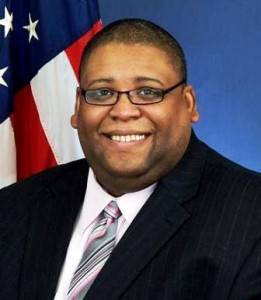David Strickland, the nation’s top automotive safety regulator, is stepping down after nearly four years on the job.
The 45-year-old Strickland is expected to leave within two months, according to a spokesperson for the U.S. Department of Transportation. While a replacement has not been named, the interim director for the National Highway Traffic Safety Administration will be David Friedman, a former official with the Union of Concerned Scientists.
Strickland joined NHTSA in January 2010 and has led an aggressive push to expand the use of breakthrough active safety technologies. Among other things, the agency is considering whether to require the use of new forward collision detection systems that could automatically a vehicle’s brakes if the driver did not react rapidly enough to a potential collision.
NHTSA is also pushing forward on research that could allow vehicles to communicate with one another – and with a roadway communications infrastructure – something experts believe could further reduce the likelihood of crashes.
During most of Strickland’s tenure the number of U.S. highway fatalities continued its rapid decline. The numbers blipped upward unexpectedly in 2012 but resumed a downward direction during the first half of 2013, according to preliminary NHTSA numbers.
Going into office, Strickland seemed ready to ease the often strained relationship between automotive regulators and the industry they oversaw. But then Toyota became embroiled in a highly publicized flap over so-called unintended acceleration, critics contending its vehicles would suddenly race out of control without warning. Ultimately, more than 10 million of the maker’s vehicles were recalled and both Strickland and Toyota CEO Akio Toyoda came in for sharp criticism during a series of hearings on Capitol Hill.
Since then, observers have suggested that NHTSA has gotten tougher on manufacturers, giving them less leeway to sidestep a recall when a potential safety issue was recalled. Toyota, as well as Ford, BMW and Volvo, have since been fined for not reacting quickly enough – as required by law – when potential safety defects were discovered.
(NHTSA’s Strickland disputes Musk’s claims. For more, Click Here.)
But safety advocates haven’t been entirely satisfied. NHTSA has so far delayed five times setting down guidelines on the use of rearview cameras that proponents claim could save 100s of lives a year. The law was passed by Congress in 2007 and was initially expected to take effect in 2011.
One of the most worrisome that developed under Strickland’s watch was the rapid rise in counterfeit auto parts, airbags in particular. That has triggered a number of arrests and warnings that millions of vehicles could be equipped with defective airbags following crash repairs.
(Click Here to see how federal regulators may change safety ratings.)
Among other steps NHTSA has taken under Strickland, manufacturers will be required to use audio alert systems when battery cars are driven in urban situations; and manufacturers will have to equip all of their vehicles with so-called black box data recording devices.
Strickland was a congressional aide before joining NHTSA and was actively involved in the Obama Administrations efforts to increase automotive fuel economy – first to 35 mpg by 2020 and then to 54.5 mpg by 2025
The man set to replace Strickland, at least in an acting role, is David Friedman, former deputy director of the Clean Vehicles Program for the Union of Concerned Scientists. Despite frequently battling the industry over the UCS support for battery cars and other high-mileage technologies, Friedman was named NHTSA deputy director earlier this year.

